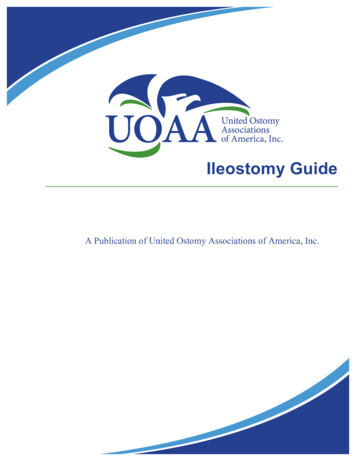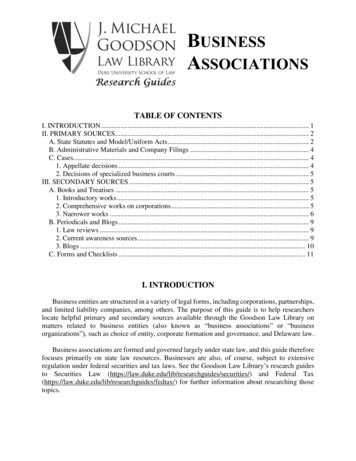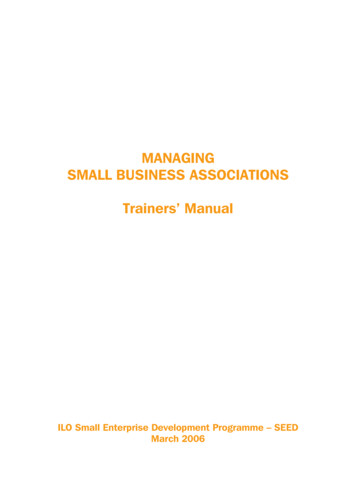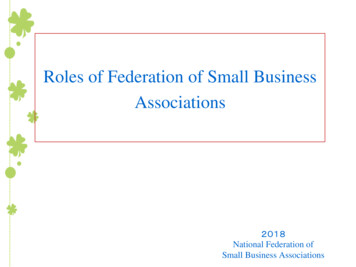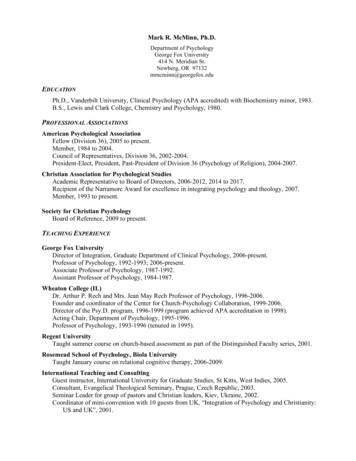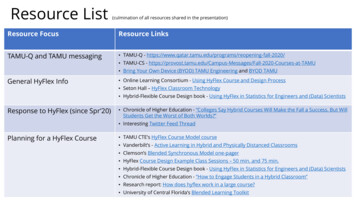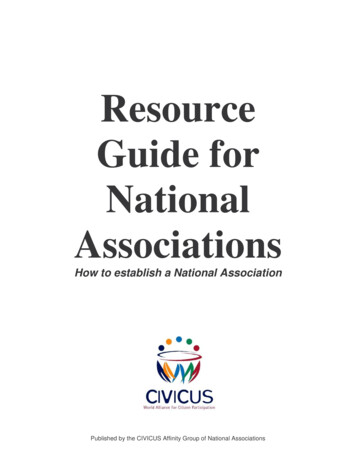
Transcription
ResourceGuide forNationalAssociationsHow to establish a National AssociationPublished by the CIVICUS Affinity Group of National Associations
Table of contents1Introduction .41.1Purpose of the guide .41.2Methodology .51.3Structure of the guide .52Understanding national associations .62.1What is a national association? .62.2Why do people and organisations set up national associations? .62.3Benefits of a national association .83Establishing a national association .103.1The process .103.1.1 Strategic intent.113.1.2 Core group.123.1.3 Action plan .153.1.4 Financing the plan .154Institutional arrangements.164.1Institutional form and structure .164.2Registering a national association .194.3Governance .194.3.1 The Governing team or board .204.3.2 Decision making .214.4Secretariat .225Running a national association .275.1Strategic Planning .275.2Membership .295.2.1 Criteria, Composition & Structure .295.2.2 Membership Development Strategy .325.2.3 Representation and participation .335.2.4 Membership services.365.2.5 Managing expectations.375.3Profiling the association .385.4Planning and running campaigns/ joint action .445.5Advocacy and lobbying .465.6Maintaining accountability and legitimacy .485.6.1 Understanding and building legitimacy .485.6.2 Understanding and building accountability .495.6.3 Self-regulation .515.7Financing a national association .515.8Sustaining a national association .555.8.1 Sustaining the vision and strategy .565.8.2 Sustaining the resources .562
5.8.3 Sustaining the Impact .585.9Measurement, monitoring and evaluation .585.9.1 Why the need M&E.585.9.2 Guidelines for developing indicators.595.9.3 Planning your M&E programme .605.9.4 Who should participate .616Relationships .616.1Working with donors .616.2Working with government .626.2.1 State relations in a democracy .606.2.2 State relations in a hostile environment.666.3Working with the business sector .686.4Building coalitions and networks .686.4.1 Why associations build coalitions and networks.686.4.2 Process of building coalitions and networks .697Concluding Thoughts and Remarks.703
1Introduction1.1 Purpose of the guideThis resource guide has been prepared by the Civicus Affinity Group of NationalAssociations (AGNA). In 2006, AGNA conducted a survey aimed at scoping nationalassociations’ needs, interests and activities1. This identified capacity building as apriority area of concern, for both national associations and non-governmentalorganisations (NGOs) that compose their memberships. This resource guide hasbeen developed in response to member feedback and suggestions.The guide is intended to enable the board and staff of existing national associationsto manage their organisations more effectively, and also to guide civil society leadersin countries where national associations of NPOs and NGOs do not exist. In this way,we hope that this resource guide will reduce the learning curve, avoid re-inventingthe wheel and strengthen national associations around of the world.This guide sets out to Provide basic information on national associations Spell out the process of establishing a national association Provide guidelines on how to run a national association Outline possible services offered by national associations Discuss relationships with other sectors and stakeholdersWithin each of these sections the resource guide aims to: Equip you with essential tools Deepen your understanding with background information and facts andfigures on the sector Provide inspiration through case studies Motivate you with practical hints and tipsIt should be noted, however, that there is no single formula for success. Contexts andconditions vary and determine what is needed and possible. For that reason, wehave focused on providing guidelines based on the experiences of existing nationalassociations.This document also intends to raise the profile of national associations by outliningthe unique role that national associations play in civil society around the globe, aswell as by highlighting their relations with the government and voluntary sectors, andtheir potential to contribute to the development and growth of a vibrant civil society.1 The survey results are based on responses from 47 national associations.4
Information box: AGNA backgroundThe CIVICUS Affinity Group of National Associations (AGNA) was launched in June 2004. ThisAffinity Group is designed to strengthen the key role that national associations play in fostering astrong and vibrant civil society. AGNA seeks to promote greater co-operation across national andregional boundaries and to strengthen the capacity of national associations’ to pursue mutualinterests.1 AGNA provides a forum for national associations to share knowledge and experience inorder to improve individual and collective impacts, and to create opportunities for joint actions onissues of mutual concern. AGNA seeks to increase the knowledge base of/about nationalassociations in order to enable more informed and targeted activities by national associations in thefuture, and in order to capture lessons-learned and prevent the reinvention of the wheel.1.2 MethodologyPrimary and secondary resources were used to inform this toolkit. A review ofliterature was conducted on national associations, civil society and coalitions. Directexperiences in establishing and running national associations were collected from thewebsites of AGNA members, along with input from AGNA surveys, memberquestionnaires and consultations and in depth interviews with six AGNA members.Further a draft of the resource guide underwent a peer-review at AGNA’s AnnualGeneral Meeting held on the 23rd of May, 2007.21.3 Structure of the guideThe guide begins in Section 2 with an overview of the sector. This includes adefinition of a national association; an examination of the reasons people andorganisations set up national associations; and an outline of the benefits of anassociation. In Section 3, the guide outlines the process of establishing a nationalassociation, including from clarifying strategic intent, setting up the core group, anddeveloping an action plan to finance the plan. Section 4 explores various institutionalarrangements and governance. Section 5 focuses on the management of a nationalassociation and covers issues of strategic planning, membership, staffing, marketing,accountability, finances, sustainability of the organisation and monitoring andevaluation. Section 6 deals with relationships with other associations, government,donors and the private sector and pulls this together with some thoughts on buildingcoalitions and networks. The guide concludes with some final thoughts from the teamin Section 7.2 Additional relevant toolkits can be found on the CIVICUS website. http://www.civicus.org/new/default.asp5
2Understanding national associations2.1 What is a national association?“National associations are formed to fill a gap that might be identified as a collectivevoice. National policies are not developed or influenced by a single organisation,hence the need for the formation of national associations. The coordination of thesector helps prohibit the government from being able to divide and rule”.3 CephasZinhumwe, Secretary General of the National Association of NGOs in ZimbabweNational associations are country-based membership networks whose raison d’êtreis to represent the collective interests of members and the not-for-profit communitymore generally.National associations play a critical part in bringing the sector together. They exist tostrengthen the voluntary sector; create an enabling environment for civil society;convene the sector; serve the needs of civil society organisations; and advocate onbehalf of the sector on specific industry-wide issues. As representatives of the civilsociety community at a national level, national associations serve as vehicles for aconstructive and coordinated voice for civil society. They are well placed to play therole of interlocutor between governments and civil society, and are in a position ofstrength to influence public policy.National associations generally play a lead role in addressing issues that havereverberating impact on the sector as a whole (e.g. not-for-profit legislation). Inissues that are more specific to a sub-sector (e.g. children’s rights), nationalassociations play more of a facilitating role by providing a forum for members withsimilar interests to collaborate, and by supporting member initiatives.2.2 Why do people and organisations set up national associations?There are a number of motivations to establish a national association. Some of thesemay include: transforming the fragmented and weakened nature of the sector;holding governments to account; overcoming restrictions on the freedoms of thesector; maximising resources and creating a forum where diverse civil societyorganisations can meet; exchanging knowledge and experience and jointly devisingsolutions to challenges plaguing the sector.The catalyst for establishing a national association varies from country to country. Itmay be civil society leaders responding to favourable conditions, or civil societyleaders wishing to protect the sector from external threats; or it may be in responseto a request from a donor or government; or some combination of these factors.Regardless of the specific motivation, the goals behind the establishment of anational association are likely to include advancing citizen participation and openingup spaces for civil society engagement. In some countries this is the sole mission,while in other it is linked to other goals such as ending poverty or promotingdemocratisation.3 Cephas. .,6
Information box: Rise of National AssociationsThe first association was set up in 1919 in England, followed in the next few decades by similarassociations in other developed countries. The real growth in the sector occurred in the 1980’s and1990’s when most of the AGNA members were established.A national association is an NGO which builds links among various fields o
6.3 Working with the business sector .68 6.4 Building coalitions and networks .68 6.4.1 Why associations build coalitions and networks.68 6.4.2 Process of building coalitions and networks.69 7 Concluding Thoughts and Remarks.70. 4 1 Introduction 1.1 Purpose of the guide This resource guide has been prepared by the Civicus Affinity Group of National Associations (AGNA). In .
